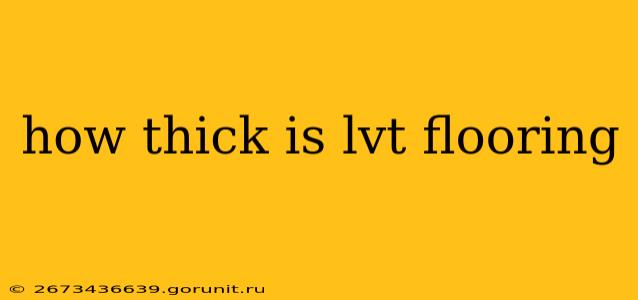Luxury vinyl tile (LVT) flooring has exploded in popularity due to its durability, water resistance, and stylish designs mimicking natural materials like hardwood and stone. But one common question among homeowners and installers alike is: how thick is LVT flooring? The answer, unfortunately, isn't a single number. LVT thickness varies significantly, and understanding this variation is crucial for making informed purchasing decisions.
Understanding LVT Thickness Variations
LVT flooring thickness is typically measured in millimeters (mm) and ranges from approximately 2mm to 8mm. This wide range significantly impacts the flooring's performance and suitability for different applications. Let's break down the common thickness categories:
Thin LVT (2mm - 4mm):
- Thickness: These are the thinnest options, often referred to as "thin-set" LVT.
- Pros: Lightweight, easy to install (often click-lock), cost-effective.
- Cons: Less durable, prone to showing imperfections in the subfloor, less sound insulation, not ideal for high-traffic areas. May not be suitable for areas with uneven subfloors.
- Best Use Cases: Areas with low traffic, such as bedrooms or guest rooms, or over existing smooth, even flooring.
Medium LVT (4mm - 6mm):
- Thickness: This is a popular mid-range thickness offering a balance between cost and performance.
- Pros: Relatively durable, provides moderate sound insulation, suitable for moderate traffic areas. Good balance of price and performance.
- Cons: May still show some subfloor imperfections, not ideal for extremely high-traffic areas or areas with heavy furniture.
- Best Use Cases: Living rooms, dining rooms, hallways – areas with moderate foot traffic.
Thick LVT (6mm - 8mm):
- Thickness: These are the thickest and most durable LVT options.
- Pros: Excellent durability, superior sound insulation, hides subfloor imperfections well, ideal for high-traffic areas and areas with heavy furniture. Often features thicker wear layers for increased longevity.
- Cons: More expensive, heavier, can be more challenging to install.
- Best Use Cases: High-traffic areas such as kitchens, entryways, and commercial spaces.
The Importance of the Wear Layer
While the overall thickness of the LVT plank is important, the wear layer is arguably even more crucial for longevity. The wear layer is the topmost layer of the LVT, and its thickness determines its resistance to scratches, scuffs, and stains. A thicker wear layer generally translates to greater durability and a longer lifespan. Look for LVT with wear layers ranging from 20 mils (0.5 mm) to 30 mils (0.75 mm) or more for superior performance.
Choosing the Right Thickness for Your Needs
Selecting the appropriate LVT thickness depends heavily on your individual needs and budget. Consider the following factors:
- Traffic Level: High-traffic areas require thicker LVT with a robust wear layer.
- Subfloor Condition: If your subfloor is uneven, thicker LVT will better mask imperfections.
- Sound Insulation: Thicker LVT provides better sound insulation.
- Budget: Thicker LVT is generally more expensive.
- Installation Method: Some thicker LVT options require glue-down installation.
By understanding the nuances of LVT thickness and the role of the wear layer, you can choose the perfect flooring for your home or business, ensuring both aesthetic appeal and long-lasting durability.

